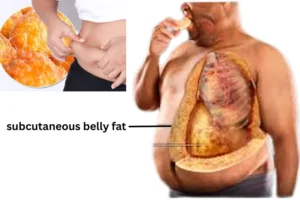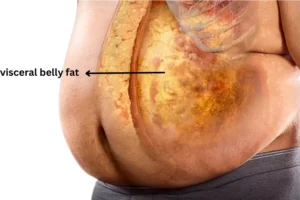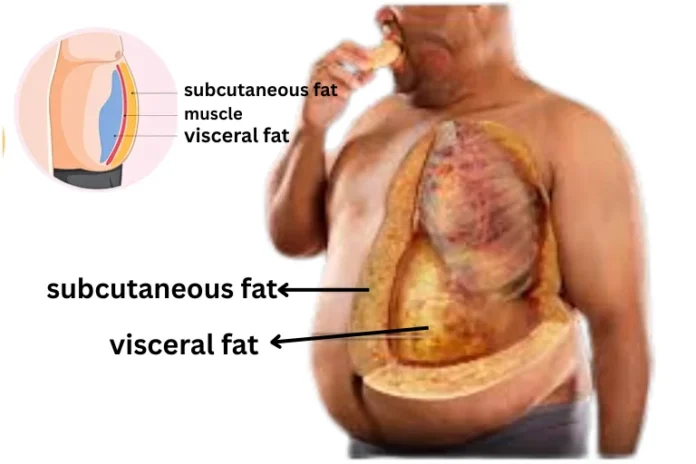Types of Belly Fat, Causes, and How to Cure It
Belly fat is a common concern for many people, not just for aesthetic reasons but also because it can pose serious health risks. Excess fat around the abdominal region is linked to various health issues, including heart disease, diabetes, and high blood pressure. Understanding the types of belly fat, their causes, and how to effectively cure them is crucial for maintaining overall health and well-being.
Types of Belly Fat
Belly fat is not just one uniform layer of fat; it is classified into two main types:
1. Subcutaneous Fat

Subcutaneous fat is the soft, pinchable fat that sits just under the skin. This type of fat is relatively harmless and serves as an energy reserve for the body. While it may affect appearance, it does not pose the same health risks as deeper fat deposits. However, excessive subcutaneous fat can still lead to obesity-related issues and impact self-esteem.
2. Visceral Fat

Visceral fat is the more dangerous type of belly fat that surrounds internal organs, such as the liver, pancreas, and intestines. It is linked to serious health conditions, including insulin resistance, inflammation, and metabolic disorders. High levels of visceral fat increase the risk of cardiovascular diseases, type 2 diabetes, and even certain cancers. This fat is more metabolically active than subcutaneous fat and releases harmful compounds that can negatively affect overall health.
Causes of Belly Fat
There are several reasons why people accumulate belly fat. Some of the most common causes include:
1. Poor Diet
A diet high in processed foods, sugar, and unhealthy fats can lead to excess belly fat. Sugary drinks, refined carbs, and trans fats contribute to fat accumulation, particularly in the abdominal area. Foods like pastries, fried foods, and excessive dairy can also play a role in weight gain.
2. Lack of Physical Activity
A sedentary lifestyle slows down metabolism and leads to fat storage, especially around the midsection. Regular physical activity is essential for burning calories and maintaining a healthy weight. People who sit for long periods without exercise are more prone to developing belly fat.
3. Stress and Cortisol Levels
Chronic stress triggers the release of cortisol, a hormone that encourages fat storage in the belly. Stress eating and poor sleep habits further contribute to weight gain. High cortisol levels not only lead to increased fat storage but also promote cravings for high-calorie foods.
4. Genetics
Some people are genetically predisposed to store fat in the abdominal region. While genetics play a role, lifestyle factors significantly influence the extent of fat accumulation. Studies suggest that some individuals have a genetic tendency to gain weight in the midsection rather than other body parts.
5. Hormonal Changes
Hormonal fluctuations, especially in women going through menopause, can lead to increased belly fat. As estrogen levels drop, fat storage shifts from the hips and thighs to the abdominal region. In men, decreased testosterone levels with age can also contribute to increased fat accumulation.
6. Alcohol Consumption
Excessive alcohol intake contributes to weight gain, particularly around the stomach. Alcohol is high in empty calories and can lead to poor food choices. Drinking alcohol in excess also affects liver function, making it harder for the body to burn fat efficiently.
7. Lack of Sleep
Poor sleep patterns can disrupt hormone levels, leading to increased hunger and cravings for unhealthy foods. Lack of sleep is also linked to higher stress levels and weight gain. People who sleep less than six hours per night are more likely to have excess belly fat.
8. Aging
As people age, their metabolism slows down, making it easier to gain weight. Muscle mass naturally declines with age, which can lead to increased fat accumulation if not countered with strength training and an active lifestyle.
How to Cure Belly Fat
Reducing belly fat requires a combination of lifestyle changes, including diet, exercise, stress management, and healthy habits. Here are some effective ways to get rid of belly fat:
1. Adopt a Healthy Diet
Eating a balanced diet is key to reducing belly fat. Consider the following dietary changes:
Increase Protein Intake: Protein helps boost metabolism, reduce appetite, and promote fat loss. Sources include lean meats, eggs, fish, tofu, and legumes.
Cut Back on Sugar and Refined Carbs: Avoid sugary drinks, processed snacks, and white bread. Choose whole grains like quinoa, brown rice, and whole wheat bread.
Eat More Fiber: Soluble fiber from vegetables, fruits, and whole grains helps reduce fat absorption and keeps you full longer. Foods like oats, flaxseeds, and chia seeds are excellent choices.
Choose Healthy Fats: Opt for healthy fats like avocados, nuts, seeds, and olive oil instead of trans fats found in fried and processed foods.
Stay Hydrated: Drinking enough water helps with digestion, metabolism, and appetite control. Aim for at least 8 glasses of water per day.
2. Exercise Regularly
Physical activity is crucial for burning belly fat. The best exercises for targeting belly fat include:
Cardio Workouts: Running, swimming, cycling, and brisk walking help burn calories and reduce fat.
Strength Training: Building muscle through weight training increases metabolism and helps burn fat.
Core Exercises: While spot reduction is a myth, strengthening core muscles improves abdominal tone and posture.
High-Intensity Interval Training (HIIT): Short bursts of intense exercise followed by rest periods help burn more fat in less time.
3. Manage Stress Levels
Reducing stress can help control cortisol levels and prevent fat accumulation. Effective stress management techniques include:
Meditation and Deep Breathing: Practicing mindfulness and breathing exercises can help reduce stress.
Engaging in Hobbies: Activities like painting, gardening, or reading can relax the mind.
Regular Exercise: Physical activity is one of the best ways to relieve stress and improve mood.
4. Get Enough Sleep
Quality sleep is essential for weight management. Aim for 7-9 hours of sleep per night and follow these tips:
Maintain a Regular Sleep Schedule: Go to bed and wake up at the same time each day.
Limit Screen Time Before Bed: Reduce exposure to blue light from phones and computers.
Create a Relaxing Bedtime Routine: Reading or listening to calming music can help you unwind.
5. Limit Alcohol Consumption
Reducing alcohol intake can help prevent weight gain. If you drink, do so in moderation and opt for lower-calorie options like dry wine or light beer.
6. Stay Consistent and Track Progress
Tracking your progress with a food diary or fitness app can keep you accountable. Consistency is key—results take time, so be patient and stay committed.
7. Seek Professional Help if Needed
If lifestyle changes are not yielding results, consulting a doctor or nutritionist can provide personalized guidance. In some cases, medical conditions may contribute to belly fat accumulation, requiring professional intervention.
Conclusion
Belly fat is a serious health concern, but it can be managed with the right lifestyle choices. By understanding the types of belly fat, their causes, and how to effectively reduce them, you can take proactive steps toward a healthier life. Adopting a nutritious diet, staying physically active, managing stress, and maintaining good sleep habits are essential for losing belly fat and improving overall well-being. Remember, small, consistent changes lead to long-term success.

